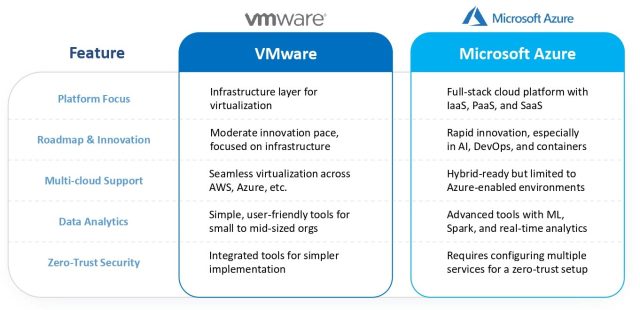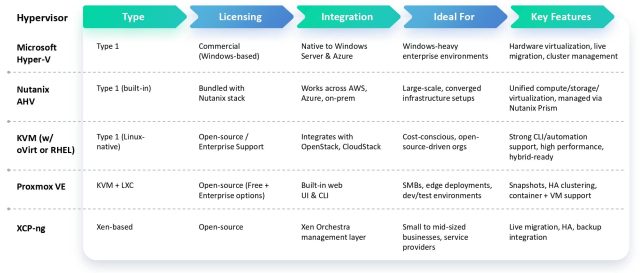Following VMware’s acquisition by Broadcom, businesses began experiencing sharp changes such as higher licensing costs, bundled packages, longer support cycles, and a lack of clarity, forcing many to rethink their VMware migration strategy. For enterprises, this quickly turned into a bottleneck. This led to a worsening of customer support, presenting the above challenges.
Onboarding new customers still running VMware became slow, error-prone, and resource-intensive.
Enterprises are increasingly looking into VMware exit strategies that support next-generation platforms and cloud-native solutions.
That’s when they partnered with Calsoft. Calsoft combines strong infrastructure expertise, agile platform capabilities, and AI-enabled solutions to help enterprises simplify and accelerate their VMware migration.
Calsoft built a lightweight, CLI-based migration tool that automated discovery, disk conversion, validation, and parallel VM transfers. This enabled customers to migrate independently, without GUI tools or extensive platform knowledge. It restored autonomy, reduced support load, and accelerated time-to-cloud.
Read/Get the full case study: Seamless VMware Migration for Cloud Edge Providers | Calsoft Inc
This blog explores the alternatives to VMware—transitioning to alternative hypervisor solutions to modern cloud-native platforms—and how to pick the right one for your business.
Why Consider VMware Alternatives?
VMware can be costly and complex, especially for small to mid-sized businesses. Key drawbacks include difficult licensing, high hardware demands, limited compatibility with the tools, vendor lock-in, and a steep learning curve.
How to choose the right VMware Alternative?
Look for a solution that offers automation, cost control, scalability, and strong performance. It should integrate well with your existing tools, be easy to use, and enable reliable support and community resources.
Ultimately, choosing the right VMware alternative is not a one-size-fits-all approach; it depends on your organization’s size, goals, priorities, and budget.
Download our latest whitepaper to get more insights on how to migrate away from VMware.
Here are some of the most common questions enterprises ask when evaluating alternatives, along with what you need to know to make the right choice.
Also Read: A Step-by-Step VMware Migration Guide [2… – Calsoft Blog
What is the current replacement for a VMware server?
According to a Foundry and CIO.com survey of over 550 enterprise IT leaders, over 56% of surveyed enterprises plan to decrease their use of VMware over the next year, with 71% actively looking at on-premises alternatives. So, if you’re moving away from VMware’s core server virtualization platform, here are the leading server virtualization alternatives to consider.
These hypervisors offer viable alternatives to VMware based on your environment, budget, and long-term strategy. Whether you’re leaning toward commercial platforms or open-source flexibility, Calsoft helps evaluate and implement the best-fit virtualization stack.
What is a free alternative to VMware ESXi hypervisor?
With VMware ESXi now locked behind a paid subscription, many organizations are exploring free hypervisor alternatives:
Proxmox VE
Proxmox VE (Virtual Environment) is an open-source virtualization platform that seamlessly combines two Linux-based technologies: KVM (Kernel-based Virtual Machine) for deploying virtual machines, and LXC (Linux Containers) for creating and managing containers.
The platform offers advanced features for managing storage, network configurations, and high-availability clusters. Users can access these functionalities through an intuitive web interface or a traditional command-line interface (CLI), making Proxmox VE a versatile solution for a variety of virtualization needs.
XCP-ng
XCP-ng (Xen Cloud Platform – Next Generation) is an open-source virtualization platform derived from XenServer. It was created as a community-driven project to offer a free alternative to Citrix Hypervisor.
This platform can be deployed in a variety of environments, including home labs, small businesses, and large enterprises.
oVirt
oVirt is an open-source virtualization management platform that is built on KVM (Kernel-based Virtual Machine). It serves as a community-driven alternative to Red Hat Virtualization, offering comparable features and functionality.
While oVirt and Red Hat Virtualization share a common foundation, oVirt is available for free and is maintained by a community of developers. This makes it a cost-effective solution for managing virtualized environments.
While free doesn’t always mean risk-free, Calsoft often helps clients wrap these platforms with enterprise-grade tooling, backups, and automation pipelines.
What is the best alternative to VMware vSphere?
When replacing VMware vSphere, you’ll need both a new hypervisor and a management layer for VM lifecycle orchestration. Consider:
OpenStack
OpenStack is not just a simple hypervisor. It is open-source VMware alternative and cloud operating system. It is a complex and powerful collection of connected projects. Together, they let you build and manage your own private or public cloud, much like the systems that run AWS or Azure.
It supplies a full set of services for computing (Nova), storage (Cinder/Swift), and networking (Neutron). Everything is managed through a single dashboard (Horizon).
OpenStack is the ultimate do-it-yourself private cloud platform. It is not a simple replacement for vSphere. It is a VMware alternative for large businesses, service suppliers, and research groups.
Red Hat OpenShift Virtualization
Red Hat OpenShift is a leading Kubernetes platform for businesses. This alternative to VMware has evolved into a powerful, unified solution for managing both containers and virtual machines.
With OpenShift Virtualization, which is based on the open-source KubeVirt project, developers and administrators can manage virtual machines (VMs) and containers together. This can be done on the same platform using the same tools and processes.
OpenShift is an excellent choice for companies transitioning to a cloud-native future while still maintaining many legacy applications on VMs. It enables you to update your systems at your own pace, eliminating the need for separate systems for VMs and containers.
AWS (Amazon Web Services)
Amazon Web Services (AWS) is the leading public cloud provider, offering a powerful alternative to running VMware on your premises. Instead of managing your own hardware and hypervisors, you can leverage Amazon’s extensive global infrastructure.
The core of its virtualization service is Amazon EC2 (Elastic Compute Cloud). This VMware-like software allows you to set up virtual servers, known as instances, in just a matter of minutes.
Transitioning to AWS involves changing your spending model. You shift from making upfront hardware purchases (CapEx) to paying for the services you consume (OpEx). This alternative to VMware provides you with enhanced flexibility and the capability to scale your operations efficiently.
For organizations prioritizing customizable environments, RHV or OpenStack may be more suitable.
What Can Be an Alternative for Deploying Virtual Machines?
Alternatives to deploying virtual machines (VMs) include containers, bare-metal servers, and cloud-native platforms. Containers offer a lighter, faster, and more portable way to run applications.
VM deployment today is about speed, security, and integration with DevOps. Alternatives include
Public Cloud:
- AWS EC2
- Azure Virtual Machines
- Google Cloud Compute Engine
Hybrid On-Prem + Cloud:
- Azure Stack HCI
- OpenShift Virtualization
- Harvester (by SUSE) or Rancher for Kubernetes-native VM orchestration
Calsoft regularly helps businesses define the right blend of on-prem and cloud deployment. We build migration blueprints, integrate provisioning pipelines, and enforce security policies across environments.
Which Is Better for the Future —VMware or Microsoft Azure?
VMware and Microsoft Azure are two prominent players in this space, each offering unique solutions to address the challenges of multi-cloud environments, data analytics, and security. Below is a concise comparison highlighting their key features and approaches.

Takeaway
Virtualization isn’t one-size-fits-all anymore. Whether you’re looking to cut costs, scale workloads, or modernize your stack, alternatives to VMware are mature, stable, and enterprise-ready.
Calsoft offers a structured, automation-first migration approach backed by years of hands-on experience.
Start with a free consultation or download our VMware Migration Blueprint.
Frequently Asked Questions (FAQs)
Q1: What is the current replacement for a VMware server?
A. Microsoft Hyper-V, Nutanix AHV, and KVM are top replacements depending on your environment. Hyper-V suits Windows-heavy setups, while KVM and Nutanix offer flexibility and scale.
Q2: What is a free alternative to VMware ESXi hypervisor?
A. Proxmox VE, XCP-ng, and oVirt are free, open-source alternatives. Each provides enterprise-level features without licensing fees, suitable for dev/test or even production use.
Q3: What is the best alternative to VMware vSphere?
A. OpenStack and Red Hat OpenShift Virtualization are strong alternatives. They offer VM lifecycle management, orchestration, and hybrid/cloud-native readiness.
The post VMware Alternative: Best Replacement Solutions for Cost, Control & Cloud Readiness appeared first on Calsoft Blog.


